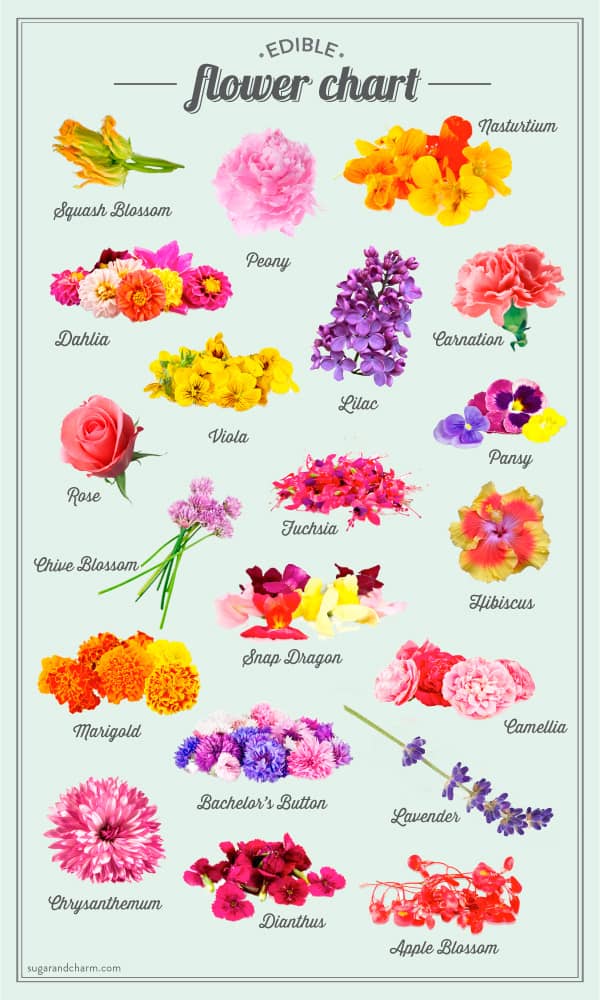
Begonia Flowers - Tuberous begonias (Begonia X tuberosa) and Waxed begonias (Begonia cucullata)
Tuberous Begonias (Begonia X tuberosa) – The leaves, flowers, and stems are edible. Begonia blossoms have a citrus-sour taste. The petals are used in salads and as a garnish. Stems, also, can be used in place of rhubarb. The flowers and stems contain oxalic acid and should not be consumed by individuals suffering from gout, kidney stones, or rheumatism.
Wax Begonias (Begonia cucullata) – The fleshy leaves and flowers are edible raw or cooked. They can have a slight bitter after taste and if in water most of the time, a hint of swamp in their flavor.

Camellia flowers
Camellia is most often grown as an early flowering shrub, but its leaves make a traditional tea when dried, and its flowers have been used in Asian cuisine for centuries.
Despite their beauty, camellia flowers are fairly flavourless but make a great garnish that’s safe to eat.
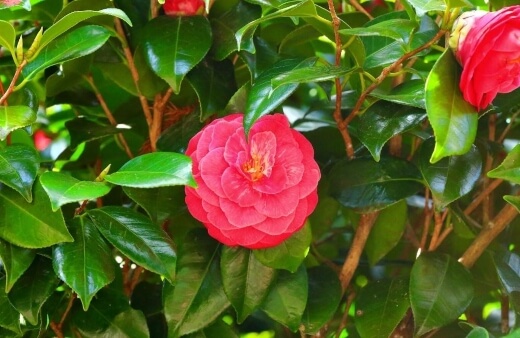
Calendula (Calendula officinalis)
The flowers from these bright orange or golden annuals—also called pot marigolds—add a bitter zest to salads. A wonderful edible flower. Flavors range from spicy to bitter, tangy to peppery. Their sharp taste resembles saffron (also known as Poor Mans Saffron). Has pretty petals in golden-orange hues. Sprinkle them on soups, pasta or rice dishes, herb butters, and salads. Petals add a yellow tint to soups, spreads, and scrambled eggs. Only the petals are edible.
Grow them from seeds in the cooler weather months, as they don’t like heat. Bonus: Butterflies also love this plant!
See Calendula seeds
Carnations (Dianthus caryophyllus – aka Dianthus)
Carnations can be steeped in wine, candy, or use as cake decoration. To use the surprisingly sweet petals in desserts, cut them away from the bitter white base of the flower. Dianthus are the miniature member of the carnation family with light clove-like or nutmeg scent. Petals add color to salads or aspics. Carnation petals are one of secret ingredients that has been used to make Chartreuse, a French liqueur, since the 17th century.
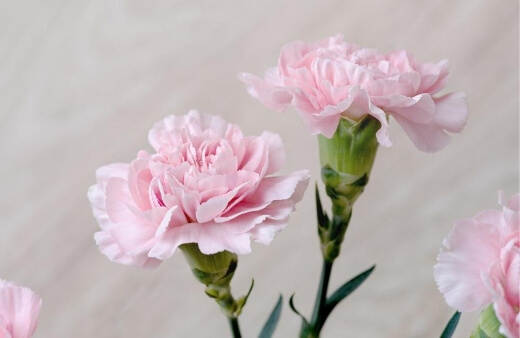
Chamomile flowers (Matricaria chamomilla and Chamaemelum nobile)
German chamomile (Matricaria chamomilla) is widely cultivated by people as a medicinal plant. Healers have known and utilised the benefits of chamomile for thousands of years. Anglo-Saxons believed it to be one of just nine sacred herbs given to humans from God. Germanic tribes and Egyptians revered the flower as a sacred plant of their sun deities. Still today, many people swear by its beneficial powers. Chamomile can be used to help treat many different ailments, such as inflammations, stomach aches and colds.
Roman chamomile (Chamaemelum nobile) can also be used as a medicinal plant.
The flowers, buds and leaves of chamomile are all edible and can be used in the kitchen. Roman chamomile is also suitable for human consumption. It smells and tastes subtly of apples.
Chrysanthemums (Chrysanthemum coronarium)
All chrysanthemums have edible flowers with a strong spicy taste. Garland chrysanthemums were traditionally used as a spice alternative in Japanese cooking and they add a very distinct flavour similar to pepper but with grassy bitterness.
Tangy, slightly bitter, ranging in colors from red, white, yellow and orange. They range in taste from faint peppery to mild cauliflower. They sould be blanched first and then scatter the petals on a salad. The leaves can also be used to flavor vinegar. Always remove the bitter flower base and use petals only. Young leaves and stems of the Crown Daisy, also known as Chop Suey Greens or Shingiku in Japan, are widely used in oriental stir-fries and as salad seasoning.

Clover (Trifolium species)
Sweet, anise-like, licorice. White and red clover blossoms were used in folk medicine against gout, rheumatism, and leucorrhea. It was also believed that the texture of fingernails and toenails would improve after drinking clover blossom tea. Native Americans used whole clover plants in salads, and made a white clover leaf tea for coughs and colds. Avoid bitter flowers that are turning brown, and choose those with the brightest color, which are tastiest. Raw flower heads can be difficult to digest.
Cornflowers (Centaurea cyanus)
Did you know the dried blue petals of cornflowers are often found in earl grey leaf tea blends?
Also called Bachelors button. They have a slightly sweet to spicy, clove-like flavor. Bloom is a natural food dye. More commonly used as garnish.
Plant cornflower seeds in autumn for flowers in spring. They grow well in a sunny position in raised beds or large containers. Cornflower plants can grow up to 90cm tall and the more you pick the flowers, the more they’ll bloom.
Cornflowers are a brilliant meadow plant and despite not being native to Australia, are brilliant for pollinators, and will help attract wildlife into the garden.
The fluffy blue flowers are sweet and spicy with a slightly medicinal zing. They lose their flavour when cooked, so sprinkle them over meals as a garnish.
See Cornflowers seeds
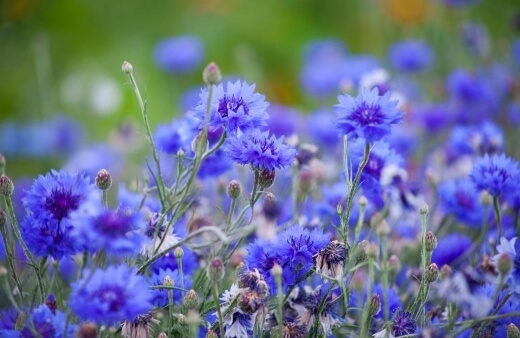
Dahlia
Dahlias are constantly going in and out of fashion as their striking blooms very much love them or loathe them flowers that can often draw attention away from the rest of a border, with their proud fireworks standing tall above their varied foliage.
Dahlias were edible and there is no simple way to explain their flavour. Their tubers can be eaten and cooked and taste like nutty carrots, while the flowers can taste anything from onion to apple.

Dame’s Rocket (Hesperis matronalis)
Also called Sweet Rocket or Dame’s Violet. This plant is often mistaken for Phlox. Phlox has five petals, Dame’s Rocket has just four. The flowers, which resemble phlox, are deep lavender, and sometimes pink to white. The plant is part of the mustard family, which also includes radishes, broccoli, cabbage, cauliflower, and, mustard. The plant and flowers are edible, but fairly bitter. The flowers are attractive added to green salads. The young leaves can also be added to your salad greens (for culinary purposes, the leaves should be picked before the plant flowers). The seed can also be sprouted and added to salads. NOTE: It is not the same variety as the herb commonly called Rocket, which is used as a green in salads.
Dandelion (Taraxacum officinalis)
Dandelions are best known as stubborn garden weeds. However, they happen to double as a highly nutritious edible flower.
Interestingly, the flowers are not the only part of dandelion that can be eaten. In fact, every part of this so-called weed can be enjoyed — including its roots, stems and leaves.
There are endless options for eating dandelion. The flowers can be eaten raw, either alone or tossed into a salad. They may be breaded and fried or used to make jelly and wine.
The roots are often steeped to make tea, while the greens may be consumed raw as a salad or a sandwich topping. They can also be cooked in stews, casseroles or any other dish that calls for hearty greens.
Member of the Daisy family. Flowers are sweetest when picked young. They have a sweet, honey-like flavor. Mature flowers are bitter. Dandelion buds are tastier than the flowers: best to pick these when they are very close to the ground, tightly bunched in the center, and about the size of a small gumball. Good raw or steamed. Also made into wine. Young leaves taste good steamed, or tossed in salads. When serving a rice dish use dandelion petals like confetti over the rice.
Day Lilies (Hemerocallis species)
Slightly sweet with a mild vegetable flavor, like sweet lettuce or melon. Their flavor is a combination of asparagus and zucchini. Chewable consistency. Some people think that different colored blossoms have different flavors. To use the surprisingly sweet petals in desserts, cut them away from the bitter white base of the flower. Also great to stuff like squash blossoms. Flowers look beautiful on composed salad platters or crowning a frosted cake. Sprinkle the large petals in a spring salad. In the spring, gather shoots two or three inches tall and use as a substitute for asparagus. NOTE: Many Lilies contain alkaloids and are NOT edible. Day Lilies may act as a diuretic or laxative; eat in moderation.
The daylily is a gorgeous plant that flowers for months in summer, but each flower lasts just one day. To make the most of their sweetly scented flowers, cut them off just below the bud and stuff the petals with rice or minced mushrooms.
The sweet nectar helps bind the stuffing and creates a moreish sweet note that’s unlike anything else you’ll grow.

English Daisy (Bellis perennis)
The flowers have a mildly bitter taste and are most commonly used for their looks than their flavor. The petals are used as a garnish and in salads.
Daisies are often considered weeds, they are a big draw for bees and butterflies, and their bright white flowers help break up swathes of green earth.
Daisy flowers don’t have much flavour and tend to taste more like the grass they are grown with, but they look wonderful sprinkled over cakes.
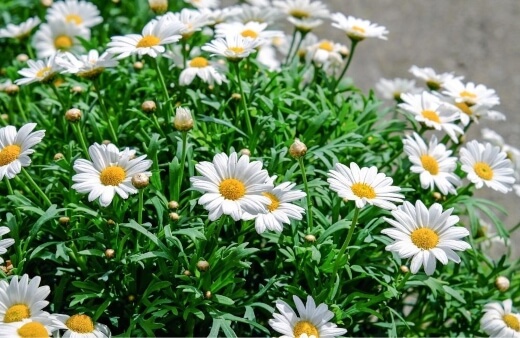
Fuchsia (Fuchsia X hybrida)
Blooms have a slightly acidic flavor. Explosive colors and graceful shape make it ideal as garnish. The berries are also edible.
Fuchsia might look like poisonous plants, and you’d be forgiven for making that mistake, with their purple and pink blossoms, and dark, blood-red berries, there are few who would risk eating Fuchsia flowers without a little research.
Fuchsia are edible though, with a sweet lemony flavour in their flowers that is subtle but worth trying. The berries are incredibly tart though, and work best cooked or stewed to make a quick syrup as a drizzle over fresh yoghurt to counteract the bitterness.
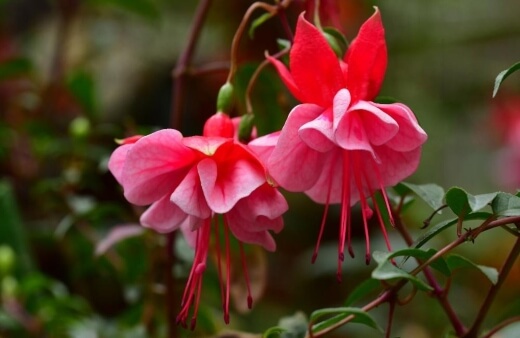
Garden Sorrel (Rumex acetosa)
Sorrel flowers are tart, lemon tasting. So use like a lemon: on pizza, a salad topping, in sauces, over cucumber salads.
Gladiolus (Gladiolus spp)
Flowers (anthers removed) have a nondescript flavor (taste vaguely like lettuce) but make lovely receptacles for sweet or savory spreads or mousses. Toss individual petals in salads. It can also be cooked like a day lily.
Gladiolus does have edible petals, but the anthers cause upset stomachs. If you do use the mildly flavoured petals in salads, make sure to remove the anther.
Hibiscus (Hibiscus rosa-sinensis)
You can eat the flower straight from the plant, but it is usually used for tea, relishes, jam or salads. The flowers can be eaten raw. Cranberry-like flavor with citrus overtones. Use slightly acidic petals sparingly in salads or as garnish. The flower can be dried to make an exotic tea.
Hibiscus plants produce large, ornate blossoms that usually grow in tropical and subtropical climates around the world. Hundreds of hibiscus species exist, but the most popular edible variety is known as roselle or Hibiscus sabdariffa.
Hibiscus heterophyllus flowers are famously used in tea infusions to add a citrus flavour. Their petals hold most of the flavour so can be stripped from the rest of the flower to help dry for storage and remove the copious amounts of pollen that doesn’t dissolve and can cloud drinks.
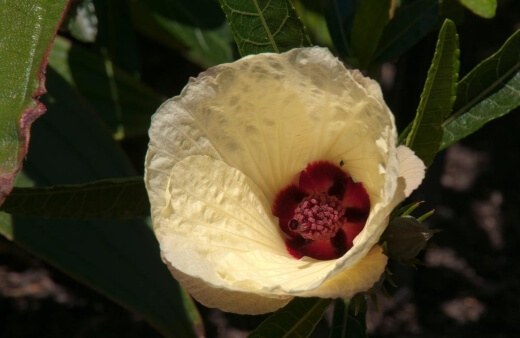
Hollyhock (Alcea rosea)
Very bland tasting flavor.
Hollyhock has to be one of the easiest impact plants you can grow in the garden, with towering spikes of flowers. Despite having very little scent on the plant, hollyhock flowers add a beautifully cucumber flavour to salads and the petals are so delicate that they almost melt in the mouth.
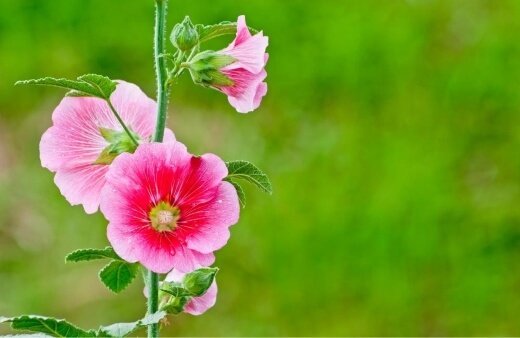
Honeysuckle (Lonicera japonica)
Sweet honey flavor. Only the flowers are edible. NOTE: Berries are highly poisonous – Do not eat them!
Almost 200 honeysuckle species exist, but the most common are the Japanese and woodbine varieties. The fragrant blossoms, typically light yellow or white, hold nectar that can be eaten straight from the flower.
Honeysuckle has been vital to traditional Chinese medicine practices for centuries.
In the culinary world, honeysuckle is most often used to make tea or a fragrant, flavorful syrup.
You can use the syrup to sweeten iced tea, lemonade, yogurt and sorbet or as a sugar replacement in quick bread recipes.
While the honeysuckle flower and its nectar are perfectly safe to eat, note that the berries of some varieties may be toxic if ingested in large quantities.
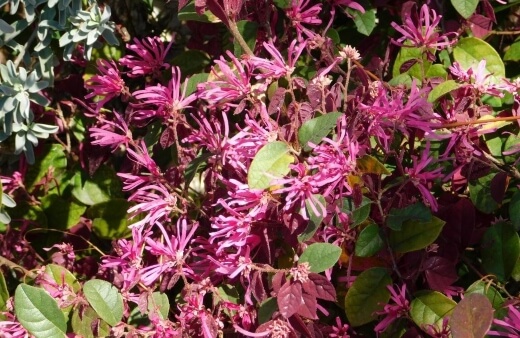
Impatiens, Busy Lizzie (Impatiens wallerana)
The flowers have a sweet flavor. They can be used as a garnish in salads or floated in drinks.
Busy Lizzies are one of the more traditional edible flowers, often used to garnish cakes and desserts without affecting their flavour. Edible flowers that don’t impact flavour are useful in the kitchen as they offer a more authentic decoration without having to use excess icing or sugar papers.
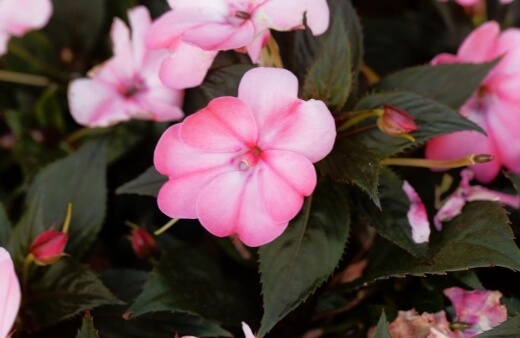
Johnny-Jump-Ups, Pansy (Viola tricolor)
Lovely yellow, white and purple blooms have a mild wintergreen flavor and can be used in salads, to decorate cakes, or served with soft cheese. They are also a great addition to drinks, soups, desserts or salads.
Pansies are a member of the viola family, but have a more varied flower form. Both are edible though, so don’t worry if you get them mixed up. Pansies and violas have wonderfully spicy lettuce flavours that are great for sweet dishes and help to cut through sugars and syrups.
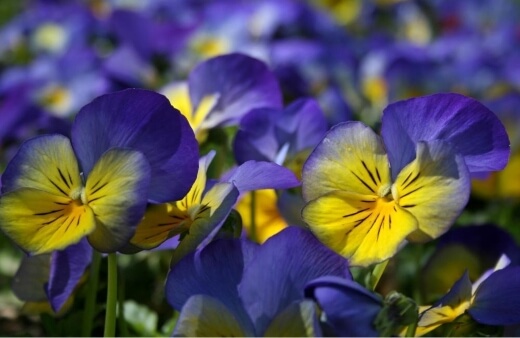
Lilac (Syringa vulgaris)
The flavor of lilacs varies from plant to plant. Very fragramt, slightly bitter. Has a distinct lemony taste with floral, pungent overtones. Great in salads and crystallized with egg whites and sugar.
Lilac, Syringa vulgaris, has one of the most iconic fragrances in the gardening world. When prepared properly, Lilac flowers can add that same fragrance to drinks and desserts, but they need stewing or steeping in water first to bring out the flavour. Eaten raw, lilac flowers are unpleasant and bitter.
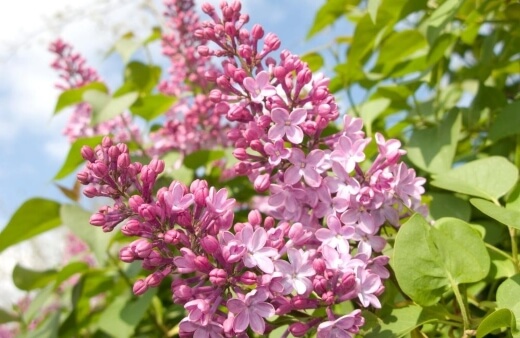
Linden (Tilla spp.)
Small flowers, white to yellow are delightfully fragrant and have a honey-like flavor. The flowers have been used in a tea as a medicine in the past. NOTE: Frequent consumption of linden flower tea can cause heart damage.
Marigold (Tagetes tenuifolia – aka T. signata)
The marigold can be used as a substitute for saffron. Also great in salads as they have a citrus flavor.
This type of marigold has a pleasant bitter tang, perfect for use in teas, salads, or as a substitute for tarragon. Remove the bitter white part at the end of petals before consuming. It’s one of the easiest annuals to grow with few diseases or pests.
Marigolds have a citrus flavour that matches the scent of their foliage. Added to salads they create an unexpected fizz of tartness which is more than enough to make sure you grow these common companion plants as a regular crop too – just beware of slugs!
See Marigold seeds
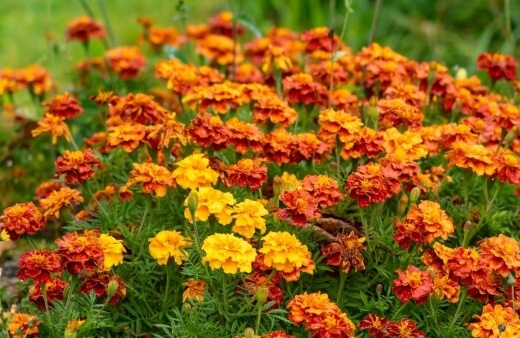
Nasturtium (Tropaeolum majus)
Comes in varieties ranging from trailing to upright and in brilliant sunset colors with peppery flavors. Nasturtiums rank among most common edible flowers. Blossoms have a sweet, spicy flavor similar to watercress. Stuff whole flowers with savory mousse. Leaves add peppery tang to salads. Pickled seed pods are less expensive substitute for capers. Use entire flowers to garnish platters, salads, cheese tortas, open-faced sandwiches, and savory appetizers.
This beautiful annual comes in an array of colors, including hot pinks, bright oranges, and golds. They’re the most versatile of the edible flowers. The pretty circular leaves, flowers, and seeds (which can be used a substitute for capers!) all add a peppery kick to salads. They’re incredibly easy to grow from seed but soak the seed overnight first to help it germinate more easily.
If you only grow one edible flower in the garden, grow nasturtiums. They are exceptionally easy to grow, and sprawl across the garden wherever they can find, often scrambling up trees to find the light.
Their leaves and flowers are both edible, with a beautiful peppery taste that works amazingly in salads far outshining rocket or radish leaves for a pepper leaf crop with the added bonus of bright orange blooms to liven up any plate.
See Nasturtium seeds
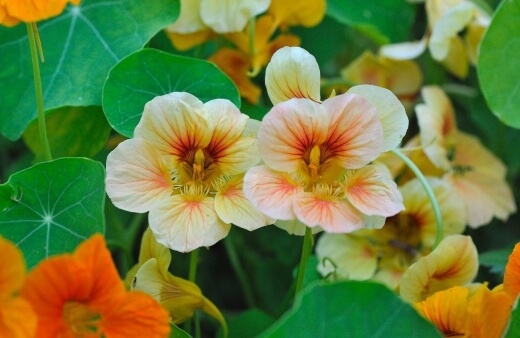
Pansy (Viola X wittrockiana)
Pansies have a slightly sweet green or grassy flavor. If you eat only the petals, the flavor is extremely mild, but if you eat the whole flower, there is a winter, green overtone. Use them as garnishes, in fruit salads, green salad, desserts or in soups.
These beautiful little flowers have a slightly fresh, grassy flavor. Use the petals or whole flowers to adorn cupcakes or add to salads.
These are easy to grow, prefer cool weather, and often drop seeds to pop up again next spring on their own.
But if that’s not enough, their lettuce flavoured flowers work beautifully as a garnish for sweet and savoury dishes in equal measure. To grow them in your garden, you’ll need a regular watering routine though as they tend to grow quite leggy in hot summers.
See Pansy seeds
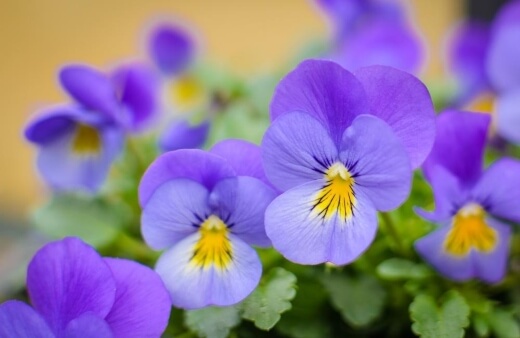
Peony flowers (Paeonia sp.)
Peony petals are edible. Peony petals are edible with a subtle sweetness that matches their pastel coloured flowers perfectly. If ever there was a flower that tastes how it looks, it’s the peony – perfect as a garnish or broken down into petals and soaked in water for a subtle hint of floral sweetness.
In China, the petals are parboiled and sweetened for use as a tea-time delicacy, in summer salads, or as garnish for delicious punches and lemonades.
These blooms hail from China and Europe, where they were often used to treat various ailments—from headaches to things like asthma and childbirth pain.
Peony petals are edible with a subtle sweetness that matches their pastel coloured flowers perfectly. If ever there was a flower that tastes how it looks, it’s the peony – perfect as a garnish or broken down into petals and soaked in water for a subtle hint of floral sweetness.
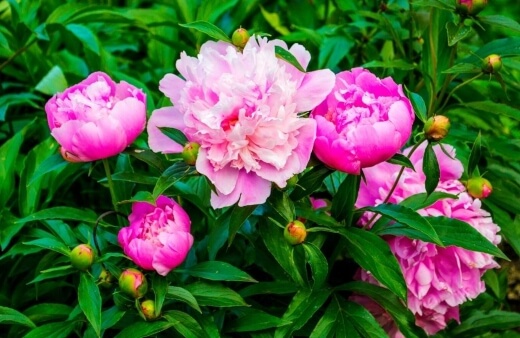
Phlox, Perrennial Phlox (Phlox paniculata)
It is the perennial phlox, NOT the annual, that is edible. It is the high-growing (taller) and not the low-growing (creeping) phlox that grows from 3 to 4 feet tall. Slightly spicy taste. Great in fruit salads. The flowers vary from a Reddish purple to pink, some white.
Phlox flowers are spicy but not overpowering. Add their edible flowers to fruit salads to bring out the flavour of fresh fruit, or preserve them by cooking them in sugar and draining them over mesh.
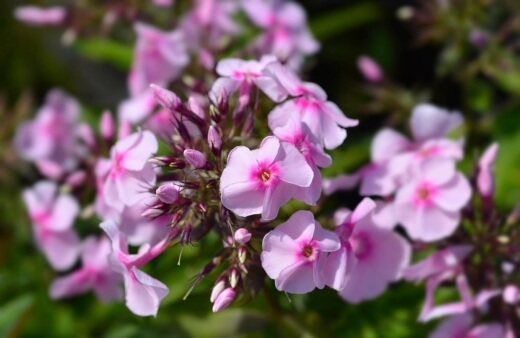
Pineapple Guave (Feijoa sellowians)
The flavor is sweet and tropical, somewhat like a freshly picked ripe papaya or exotic melon still warm from the sun.
The petals of the pineapple guava are so sweet that they are typically described as candyfloss. The entire flower is edible but it’s the petals that seem to hold the flavour best.
The petals of Feijoa plants are light and can be easily blended into smoothies as a sweetener or cooked down into chutneys to reduce sugar content.
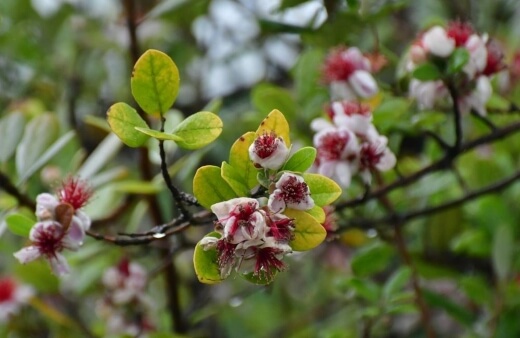
Primrose, Polyanthus, Cowslip, Primula (Primula vulgaris)
Also know as Cowslip. This flower is colorful with a sweet, but bland taste. Add to salads, pickle the flower buds, cook as a vegetable, or ferment into a wine.
The wide and diverse family of polyanthus, primroses, primulas and cowslips all have dibble flowers. While their flavour is very subtle it’s worth adding them as decorations to brighten up icing on special occasions.
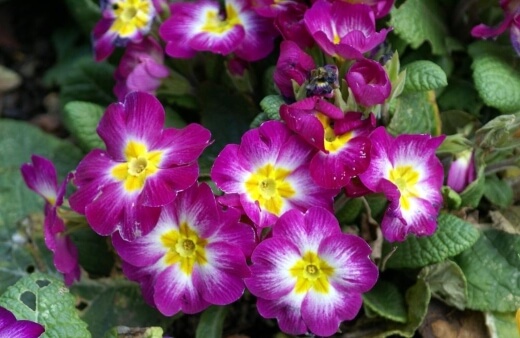
Queen Anne’s Lace (Daucus carota) – Also known as Wild Carrot and Bishop’s Lace. It is the original carrot, from which modern cultivars were developed, and it is edible with a light carrot flavor. The flowers are small and white, and bloom in a lacy, flat-topped cluster. Great in salads.
NOTE: The problem is, it is closely related to, and looks almost exactly like another wild plant, Wild or Poison Hemlock, which often grows profusely in similar habitats, and is said to be the most poisonous plant native to the United States. The best way to differentiate between the two plants is to remember that Queen Anne’s Lace has a hairy stem, while the stems of Wild Hemlock are smooth and hairless and hollow with purple spots.
Rose (Rosa rugosa or R. gallica officinalis)
Flavors depend on type, color, and soil conditions. Flavor reminiscent of strawberries and green apples. Sweet, with subtle undertones ranging from fruit to mint to spice. All roses are edible, with the flavor being more pronounced in the darker varieties. In miniature varieties can garnish ice cream and desserts, or larger petals can be sprinkled on desserts or salads. Freeze them in ice cubes and float them in punches also. Petals used in syrups, jellies, perfumed butters and sweet spreads. NOTE: Be sure to remove the bitter white portion of the petals.
This classic garden beauty has a range of flavors from sweet to spicy. The darker the petal, the more intense the flavor is. Petals can be added to ice cubes or sprinkled on cakes and over ice cream.
Roses vary massively in quality when it comes to eating, but if a rose smells good, it will taste good too. Rose petals can be used to make jams, crystallised in sugar or just used raw as a garnish.
There is pretty much no bad way of using roses, as they taste divine in any dish, sweet or savoury. Even after roses have flowers that same fragrance can be found in the bitter rose hips that follow flowers.
Recipes: Rose Petal Jam, Rose Petal Drop Scones, Rose Petal Tea
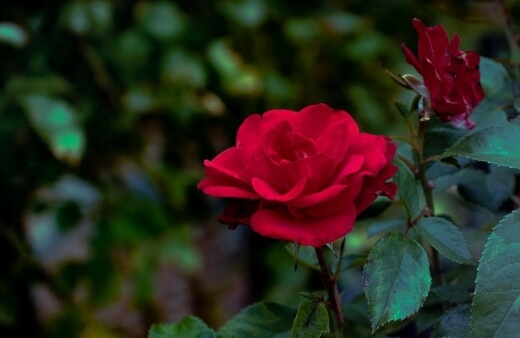
Scented Geraniums, Scented pelargoniums (Pelargonium species)
Geranium clorinda, Geranium fragrans, Geranium graveolens, Geranium quercifolia, Geranium tomentosum
Scented pelargoniums come in so many varieties that it’s hard to describe the entire species cluster in one go, but the flavour of the flowers is almost always matched to the scent of the leaf (which is also edible).
You can use the flowers or leaves to add fragrance and a zesty hit to cake mixes, or even crystallise them to sprinkle over the top of desserts for a sugar hit.
The flower flavor generally corresponds to the variety. For example, a lemon-scented geranium would have lemon-scented flowers. They come in fragrances from citrus and spice to fruits and flowers, and usually in colors of pinks and pastels. Sprinkle them over desserts and in refreshing drinks or freeze in ice cubes.
NOTE: Citronelle variety may not be edible.
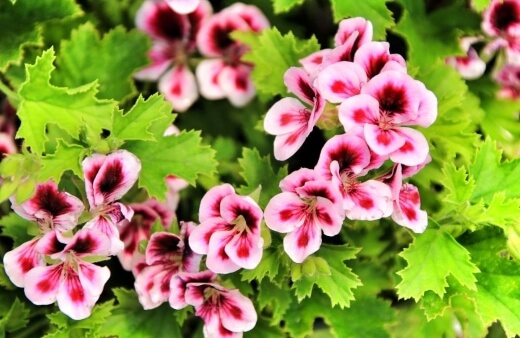
Snap Dragon (Antirrhinum majus)
Delicate garden variety can be bland to bitter. Flavors depend on type, color, and soil conditions. Probably not the best flower to eat.
Snapdragons are the epitome of edible flowers and probably the reason most people don’t really like edible flowers. Personally, I really dislike the flavour of Antirrhinums as they have a lingering bitterness, but they can work.
Try adding snapdragon flowers to a bitter salad with fresh radicchio and cos lettuce and a creamy dressing.
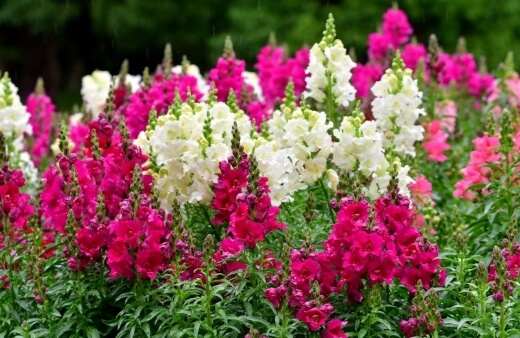
Sunflowers (Helianthus annuus)
Sunflower petals have a mild nutty flavour. Sprinkle them over salads to add a little colour. Try growing dwarf sunflower varieties in sunny windowboxes and containers. Sunflower seeds are large and easy to handle. Sow seeds from late spring until early autumn.
The flower is best eaten in the bud stage when it tastes similar to artichokes. Once the flower opens, the petals may be used like chrysanthemums, the flavor is distinctly bittersweet. The unopened flower buds can also be steamed like artichokes.
Every part of a sunflower's flower is edible and blanched or roasted in butter, they taste similar to Jerusalem artichoke. The petals don’t taste of much but do give a mild nuttiness to salads, and obviously, once they set seed, their seeds are a great way to get healthy proteins and fats into your diet too.
See Sunflowers seeds
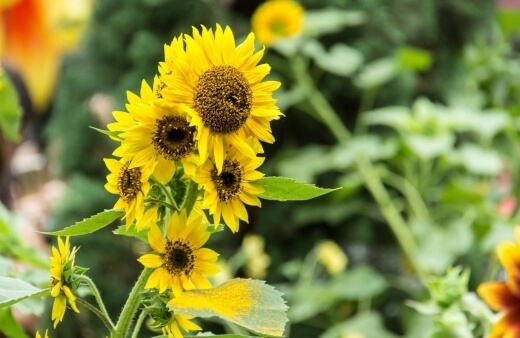
Sweet Woodruff (Galium odoratum)
Also known as Wild Baby’s Breath. The flower flavor is sweet and grassy with a hint of nutty, vanilla flavor. NOTE: Can have a blood thinning effect if eaten in large amounts
Tulip Petals (Tulipa)
Flavor varies from tulip to tulip, but generally the petals taste like sweet lettuce, fresh baby peas, or a cucumber-like texture and flavor.
NOTE: Some people have had strong allergic reactions to them. If touching them causes a rash, numbness etc. Don’t eat them! Don’t eat the bulbs ever. If you have any doubts, don’t eat the flower.
If you want to try tulip petals in salads, remove the stamen and rinse pollen from the petals before eating as they do contain small amounts of toxins.
The petals from tulip flowers have a delicate pea flavour, which is brilliant in salads, but it’s really important to remove all other parts of the plant as tulip bulbs in particular can cause severe digestive upset.
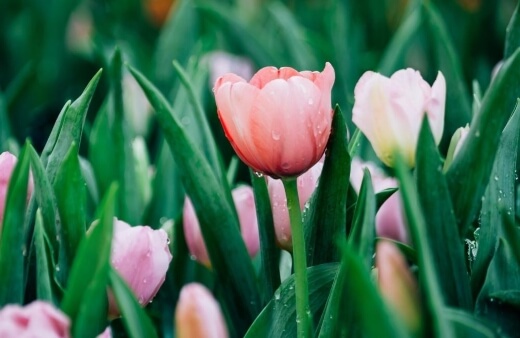
Viola (Viola odorata)
Viola flowers can be crystallized with egg white and caster sugar for edible cake decorations. Picking flowers regularly stimulates the plant to produce more.
See Viola
Violet (Viola hederacea)
Violet flowers have a delicate sweet flavor and are great in teas. You can also candy the blossoms to decorate baked goods. Both the leaves and the flowers can be tossed on salads. You'll want to purchase violets as seeds, because plants are almost impossible to find.
Viola species have sweet, perfumed flavor. Related flowers, Johnny jump-ups or violas, and pansies now come in colorful purples and yellows to apricot and pastel hues. I like to eat the tender leaves and flowers in salads. I also use the flowers to beautifully embellish desserts and iced drinks. Freeze them in punches to delight children and adults alike. All of these flowers make pretty adornments for frosted cakes, sorbets, or any other desserts, and they may be crystallized as well. Heart-shaped leaves are edible, and tasty when cooked like spinach.
See Violet seeds
Yucca Petals (Yucca species)
The white Yucca flower is crunchy with a mildly sweet taste (a hint of artichoke). In the spring, they can be used in salads and as a garnish.
Fruit Flowers:
Most fruit trees are usually sprayed just before and during the bloom. If you are using you own flowers that have not sprayed, use only the petals, not the pistils or stamen.
Acacia flowers
The blossoms are white color and have a sweet taste. They are used for herbal teas, sweets.
Acacia podalyriifolia is a native Silver Wattle, often called the Brisbane Silver Wattle or the Queensland Silver Wattle. Its culinary uses vary widely and the entire plant can be eaten as a salad crop, but its real value is its flowers.
The fluffy, pollen-rich flowers of these native acacias are incredibly sweet and can be eaten raw but are best used mixed into batter for fritters, or even folded through a falafel mix to add a hidden fragrance in place of coriander.
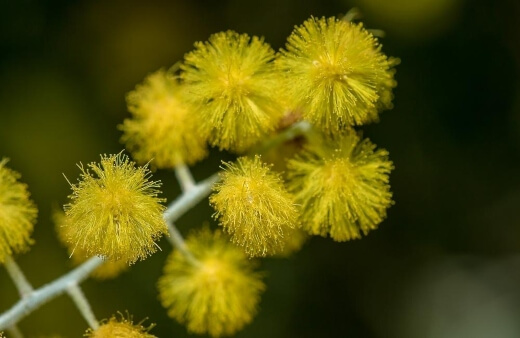
Apple Blossoms (Malus species)
Apple Blossoms have a delicate floral flavor and aroma. They are a nice accompaniment to fruit dishes and can easily be candied to use as a garnish. NOTE: Eat in moderation as the flowers may contain cyanide precursors. The seeds of the apple fruit and their wild relations are poisonous.
Obviously, apples and crab apples are edible, but did you know you can eat the flowers of Malus trees? Deepening on the soil quality in your area they can have a really sugary nectar at their base which tastes just like the scent of spring blossom.
Their flavour is designed to entice bees, and you can see why pollinators enjoy it. The real benefit of eating apple tree flowers is that it helps the tree produce bigger and better fruit. By harvesting half your bloom for salads, you reduce the fruit production, meaning the tree can focus on creating bigger, better fruit in late summer and autumn.
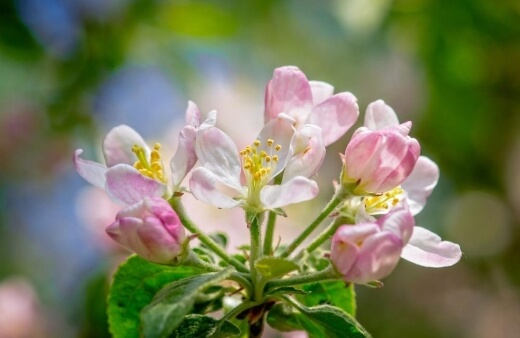
Banana Blossoms (Musa paradisiaca)
Also know as Banana Hearts. The flowers are a purple-maroon torpedo shaped growth appears out of the top of usually the largest of the trunks. Banana blossoms are used in Southeast Asian cuisines. The blossoms can be cooked or eaten raw. The tough covering is usually removed until you get to the almost white tender parts of the blossom. It should be sliced and let it sit in water until most of the sap are gone. If you eat it raw, make sure the blossom comes from a variety that isn’t bitter. Most of the Southeast Asian varieties are not bitter.
Citrus Blossoms (orange, lemon, lime, grapefruit, kumquat)
Use highly scented waxy petals sparingly. Distilled orange flower water is characteristic of Middle Eastern pastries and beverages.Citrus flavor and lemony.
Citrus flowers are known for their intense scent, with floral, nectar-rich tones of orange and lime coming through all citrus blossoms. There are many native citrus trees you can grow in your garden too, but all will thrive outdoors in most of Australia.
As with all citrus, the flowers work well in savoury and sweet dishes, but when eaten raw they have rich nectar so are a great treat if you’re walking past one in the garden.

Elderberry Blossoms (Sambucus spp)
The blossoms are a creamy color and have a sweet scent and sweet taste. When harvesting elderberry flowers, do not wash them as that removes much of the fragrance and flavor. Instead check them carefully for insects. The fruit is used to make wine. The flowers, leaves, berries, bark and roots have all been used in traditional folk medicine for centuries. NOTE: All other parts of this plant, except the berries, are mildly toxic! They contain a bitter alkaloid and glycoside that may change into cyanide. The cooked ripe berries of the edible elders are harmless. Eating uncooked berries may cause nausea, vomiting, and diarrhea.
Elderberry trees, or Sambucus, are dug out of gardens more often than planted, which is a massive shame. Yes, they spread, and they will grow almost anywhere which can make them unattractive garden plants, but the scent of elderflower in the morning through late spring is one of the most joyful moments of any gardening year.
Elderflowers make a beautiful cordial by themselves or can be mixed through cake mixes, added to drinks, or just sprinkled over salads. Always leave half of the flowers on the tree though, so you can benefit from the berries in summer.
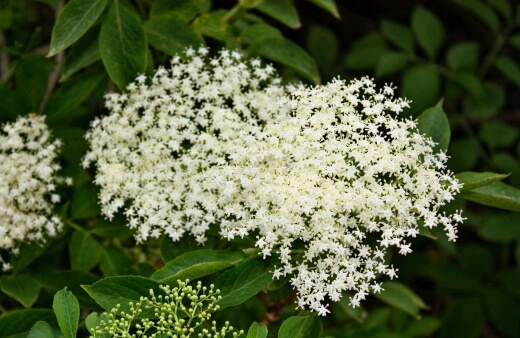
Linden flowers (Tilia cordata and Tilia platyphyllos)
The blossoms are a creamy color and have a sweet scent. They are used for herbal teas. You can eat both the flowers and leaves of linden trees. Linden leaves, for example, are excellent in a salad and the blossoms are a very popular culinary garnish and, of course, the main ingredient in linden blossom tea. The fruit is also edible and a good source of fatty acids.
Herb Flowers
Most herb flowers are just as tasty as the foliage and very attractive when used in your salads. Add some petals to any dish you were already going to flavor with the herb.
Alliums (leeks, chives, garlic, garlic chives) – Known as the “Flowering Onions.” There are approximately four hundred species that includes the familiar onion, garlic, chives, ramps, and shallots. All members of this genus are edible. Their flavors range from mild onions and leeks right through to strong onion and garlic. All parts of theplants are edible. The flowers tend to have a stronger flavor than the leaves and the young developing seed-heads are even stronger. We eat the leaves and flowers mainly in salads. The leaves can also be cooked as a flavoring with other vegetables in soups, etc.
Chive Blossoms (Allium schoenoprasum)
Use whenever a light onion flavor and aroma is desired. Separate the florets and enjoy the mild, onion flavor in a variety of dishes. Add chive flowers to salads, scrambled eggs, or omelets, either as a garnish, or cooked through.
One caution, if you’re not a big fan of onions, is that chive flowers can often have a more intense onion flavour than the leaves, so eating them whole when raw can be more than a touch overwhelming!
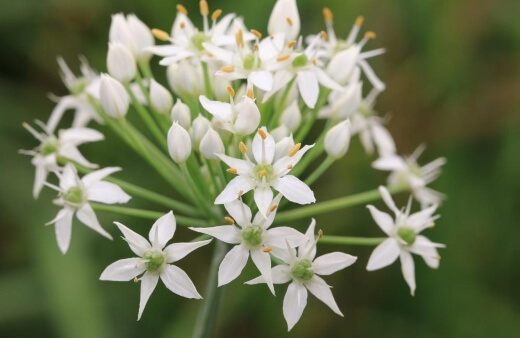
Garlic Blossoms (Allium sativum)
The flowers can be white or pink, and the stems are flat instead of round. The flavor has a garlicky zing that brings out the flavor of your favorite food. Milder than the garlic bulb. Wonderful in salads.
Angelica (Angelica archangelica)
Depending on the variety, flower range from pale lavender-blue to deep rose. It has a flavor similar to licorice. Angelica is valued culinary from the seeds and stems, which are candied and used in liqueurs, to the young leaves and shoots, which can be added to a green salad. Because of its celery-like flavor, Angelica has a natural affinity with fish. The leaves have a stronger, clean taste and make a interesting addition to salads. In its native northern Europe, even the mature leaves are used, particularly by the Laplanders, as a natural fish preservative. Many people in the cold Northern regions such as Greenland, Siberia, and Finland consider Angelica a vegetable, and eat the stems raw, sometimes spread with butter. Young leaves can be made into a tea.
Anise Hyssop (Agastache foeniculum)
Both flowers and leaves have a delicate anise or licorice flavor. Some people say the flavor reminds
them of root beer. The blossoms make attractive plate garnishes and are often used in Chinese-style dishes. Excellent in salads.
Basil (Ocimum basilicum)
Depending on the type, the flowers are either bright white, pale pink, or a delicate lavender. The flavor of the flower is milder, but similar to the leaves of the same plant. Basil also has different varieties that have different milder flavors like lemon and mint. Sprinkle them over salad or pasta for a concentrated flavor and a spark of color thatgives any dish a fresh, festive look.
Basil flowers taste, you guessed it, like basil, but true to form, they have that nectary centre designed to attract pollinators which separate the flavour of the flower from the leaf.
Add basil flowers to salads whenever you see them. By deadheading basil back to a pair of leaves you help bush out the plant and prolong its life into late summer.
Basil flowers can be eaten raw, or used mixed into sauces and soups, just like the leaves, but tend to hold their shape, so chop them small.
Recipe: Linguine with Tomatoes and Basil
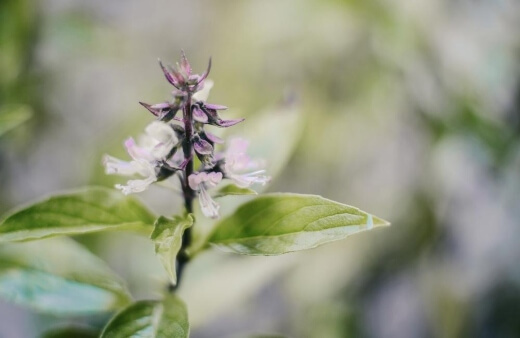
Bee Balm, Bergamot (Monarda didyma)
Also called Wild Bergamot, Wild Oswego Tea, Horsemint, Monarda. Wild bee balm tastes like oregano and mint. The taste of bee balm is reminiscent of citrus with soft mingling of lemon and orange. The red flowers have a minty flavor. Any place you use oregano, you can use bee balm blossoms. The leaves and flower petals can also be used in both fruit and regular salads. The leaves taste like the main ingredient in Earl GrayTea and can be used as a substitute.
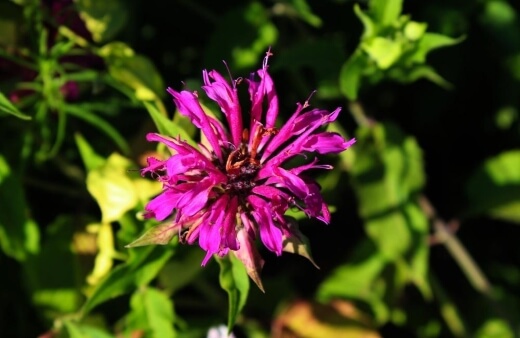
Borage (Borago officinalis)
Has lovely cornflower blue star-shaped flowers. Blossoms and leaves have a cool, faint cucumber taste. Wonderful in punches, lemonade, gin and tonics, sorbets, chilled soups, cheese tortas, and dips.
This little-known herb has edible leaves and beautiful blue flowers. Finely chop the leaves and add to salads for a light cucumber taste. They grow easily from seed and will reseed themselves for years in your garden.
Borage is not just a green manure, they’re an incredibly useful plant for the kitchen too. Borage leaves have a cucumber flavour which adds zest and freshness to salads, which is accompanied well by their nectar if you pick them early in the morning.
If you’re serious about growing flowers for salads, borage is an absolute must-have plant.
See Borage seeds

Burnet (Sanquisorba minor)
The taste usually is likened to that of cucumbers, and burnet can be used interchangeably with borage.
Chervil (Anthriscus cerefolium)
Chervil flowers are delicate white flowers with an anise flavor. Chervil’s flavor is lost very easily, either by drying the herb, or too much heat. That is why it should be added at the end of cooking or sprinkled on in its fresh, raw state in salads.
Chicory, Radicchio (Cichorium intybus)
Earthy flavor, eat either the petals or the buds. Chicory has a pleasant, mild-bitter taste that has been compared to endive. The buds can be pickled. If your salad crops have bolted, don’t throw them on the compost just yet. Bolted chicory will typically flower within a week or two, and its flowers have a milder flavour than bitter chicory, which makes an excellent addition to drinks and pickles as a replacement for celery.
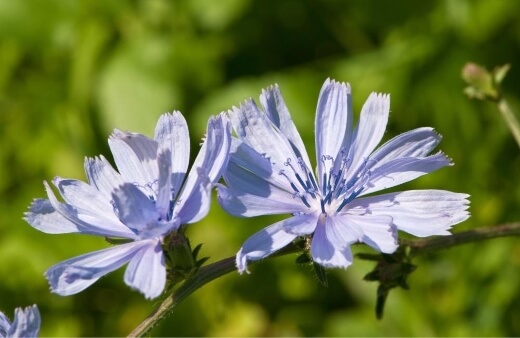
Cilantro/Coriander (Coriander sativum)
Like the leaves and seeds, the flowers have a strong herbal flavor. Use leaves and flowers raw as the flavor fades quickly when cooked. Sprinkle to taste on salads, bean dishes, and cold vegetable dishes.
You already know that the leaves of this hardy annual are edible. But the flowers also add a light citrus flavor to salads and Mexican cuisine. Plus, if you let some of the flowers go to seed, you can harvest the seeds, which are also known as the spice coriander.
Coriander flowers taste, you guessed it, just like coriander. Their flavour is slightly sweeter, but they work really well in salads and stir-fries as a twist and make the most of coriander plants that have gone past their best.
See Cilantro seeds
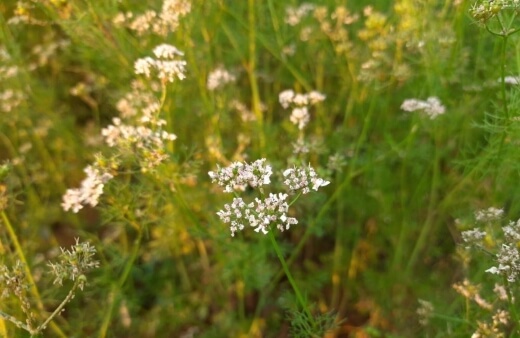
Dill (Anethum graveolens)
At the end of the season, when you’ve used all your dill leaves, these herbs flower with incredible yellow umbellifers. The flowers are milder than the seed, but slightly more pungent than the leaves, so make a great halfway point for flavouring pickles.
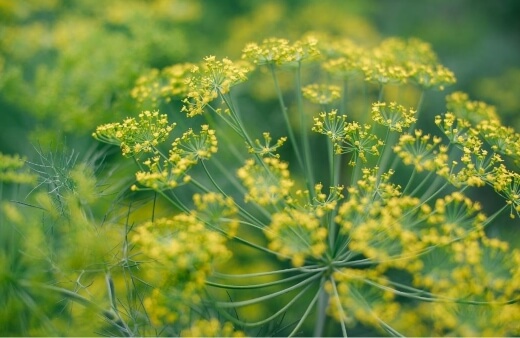
Fennel (Foeniculum vulgare)
It has a star-burst yellow flowers that have a mild anise flavor. Use with desserts or cold soups, or as a garnish with your entrees.
Fennel flowers are edible but don’t go very far. To make the most of fennel flowers, make a fennel oil by filling a bottle with the flowers, and covering them with a flavourless oil like sunflower oil, or vegetable oil.
The anise flavour of the fennel leaves and bulb can then be used to marinate squash and pumpkins for baking or BBQs.
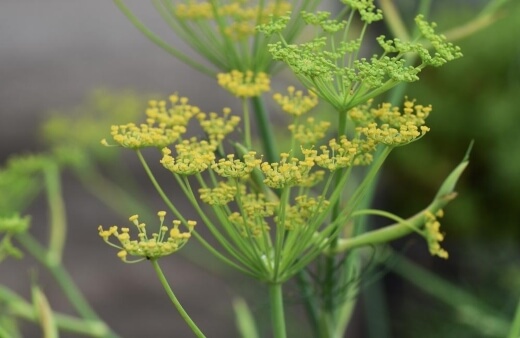
Ginger (Zingiber officinale)
The white variety of ginger is very fragrant and has a gingery taste on the tongue. Petals may be eaten raw or you can cook the tender young shoots.
Jasmine (jasmine officinale)
The flowers are intensely fragrant and are traditionally used for scenting tea. True Jasmine has oval, shiny leaves and tubular, waxy-white flowers. NOTE: The false Jasmine is in a completely different genus, “Gelsemium”, and family, “Loganiaceae”, is considered too poisonous for human consumption. This flower has a number of common names including yellow jessamine or jasmine, Carolina jasmine or jessamine, evening trumpet flower, gelsemium, and woodbine. Lavender Flowers
True jasmine is hard to come by in garden centres these days, often replaced with Cape Jasmine which is easier to grow in Australia, but there is nothing that compares to the afternoon fragrance of jasmine in full sun.
The flowers can be used to make a traditional jasmine tea but add a heavy floral fragrance to cooking without the sweetness of Cape Jasmine which means they work well in both savoury and sweet dishes.
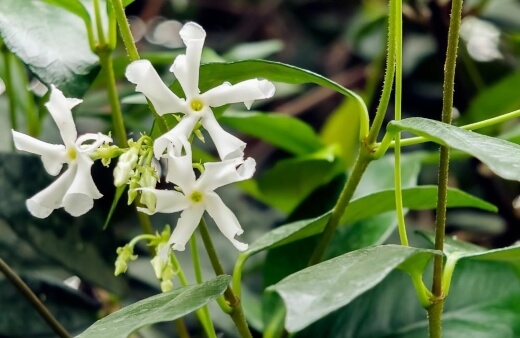
Lavender flowers (Lavandula angustifolia)
Sweet, floral flavor, with lemon and citrus notes. Flowers look beautiful and taste good too in a glass of champagne, with chocolate cake, or as a garnish for sorbets or ice creams. Lavender lends itself to savory dishes also, from hearty stews to wine-reduced sauces. Diminutive blooms add a mysterious scent to custards, flans or sorbets. NOTE: Do not consume lavender oil unless you absolutely know that it has not be sprayed and is culinary safe.
Lavender's flowers have a lovely, intensely sweet flavor. Use them baked in scones, added to teas, candied for cakes, or to dress up salads. Lavender is a perennial, so choose a type that will grow in your USDA Hardiness Zone and enjoy it year after year.
Everyone’s familiar with the calming scent of lavender, so it won’t come as a surprise that all species of lavender are edible too. Use the leaves and flower to flavour syrups, make herbal teas, or mix into biscuits and cake mixes.
There is nothing you can’t do with lavender flowers.
Recipies: Cottage Cheese-Herb Bread, Crostini with White Truffle and Olive Paste, Grilled Pork Chops with Lavender Flowers, Lavender Creme Brulee, Lavender Focaccia, Lavender Hazelnut Bread, Lavender Jelly, Lavender Sorbet, Lavender Tea Cookies, Peppered Lavender Beef

Lemon Verbena (Aloysia triphylla)
Tiny cream-colored citrus-scented blossoms. Leaves and flowers can be steeped as an herbtea, and used to flavor custards and flans.
Lovage (Levisticum officinale)
Lovage is an old-fashioned perennial herb that isn’t well-known, but it imparts a celery-like flavor to a variety of dishes. Use the leaves for tea, but add the flowers to salads or soups. Grow this from seeds as it may be difficult to find in plant form.
See Lovage seeds
Marjoram,(Origanum majorana)
Flowers are a milder version of plant’s leaf. Use as you would the herb.
Mint flowers (Mentha spp)
The flavor of the flowers are minty, but with different overtones depending on the variety. Mint flowers and leaves are great in Middle Eastern dishes.
Many different flavors of mint exist ranging from peppermint to chocolate. The flowers and leaves can be added to teas, jellies, and sauces for lamb dishes. Mint is hardy, so it can be invasive. Instead of planting it in the ground, keep it in a pot to control the spread of this hardy herb.
All varieties of mint have edible flowers, including the native River Mint. Mint flowers go incredibly well with chocolate but work in savoury foods too. Chopped up finely they can be added to anything for cooking or eaten raw just as well.
One precaution when growing mint as a crop is to keep it contained. Mint spreads easily with sprawling roots and stems that happily root into any soil they can find, so grow mints in pots, or restrict their roots.
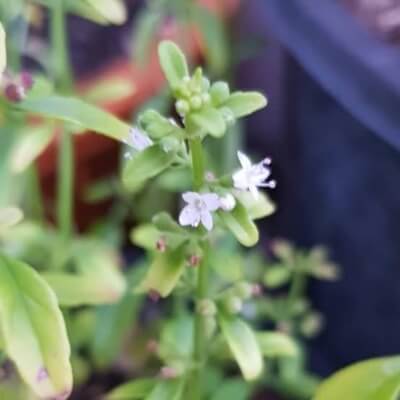
Oregano (Origanum vulgare)
Milder version of plant’s leaf. Use as you would the herb.
Oregano flowers are a perfect finishing touch to garnish pizza or pasta dishes, with that classic Mediterranean flavour that matches their leaves, but with a blue-white colour that brightens up often mono-tone dishes.
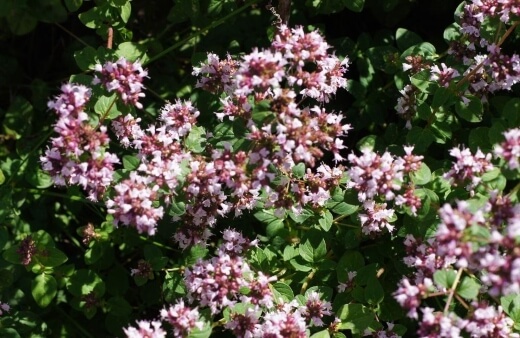
Rosemary (Salvia rosmarinus)
Milder version of leaf. Fresh or dried herb and blossoms enhance flavor of Mediterranean dishes. Use with meats, seafoods, sorbets or dressings.
Rosemary flowers are a good way to change up your normal culinary habits. Their flavour is pretty much identical to rosemary leaves but with a texture that melts away when cooked, or dissolves in the mouth when sprinkled over roast dinners.
To spice things up a little try mixing rosemary flowers into cake batter, or biscuit doughs for a savoury twist. Rosemary flowers and leaves can be used with poultry or pork - try adding a few flowers to biscuit dough to add flavour.
Recipies: Lemon Rosemary Chicken
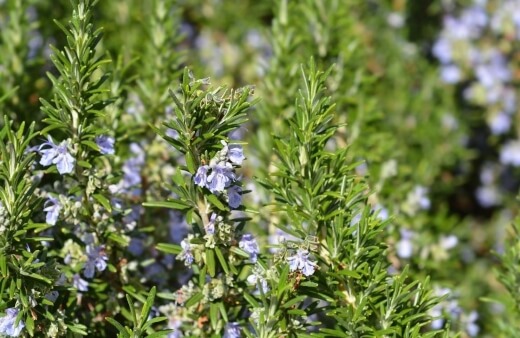
Safflower (Carthamus tinctorius)
The dried flowers, Mexican saffron, are used as a food colorant in place of the more aromatic and expensive Spanish saffron.
Sage (Salvia officinalis)
The flowers are violet-blue, pink or white up to 1 3/8 inches long, small, tubelike, clustered together in whorls along the stem tops. Flowers have a subtler sage taste than the leaves and can be used in salads and as a garnish. Flowers are a delicious companion to many foods including beans, corn dishes, sauteed or stuffed mushrooms, or pesto sauce.
Sage is the one salvia you can be sure is safe to eat, with scented leaves holding most of their flavour, many are surprised by just how beautifully delicate sage flowers are.
Sage flowers are edible though and make an excellent addition to pretty much any savoury dish you can think of, either cooked or raw.

Savory (Satureja hortensis)
The flavor of the flowers is somewhat hot and peppery and similar to thyme.
Thyme flowers (Thymus spp.)
Milder version of leaf. Use sprigs as garnish or remove flowers and sprinkle over soups, etc. Use thyme anywhere a herb might be used.
The thyme flowers have a milder flavor than the leaves and can be used in soups or salads. This perennial herb grows in almost any soil type and is drought resistant once established. This plant grows easily from seed and spreads rapidly as an attractive ground cover.
Vegetable Flowers
Did you know that broccoli, cauliflower, and artichokes are all flowers? Also the spice saffron is the stamen from the crocus flower? Capers are unopened flower buds to a bush native in the Mediterranean and Asian nations. The general rule is that the flowers of most vegetables and herbs are safe to eat. Always check first, because as with anything in life, there will always be exceptions. NOTE: Avoid – the flowers of tomato, potato, eggplant, peppers and asparagus.
Arugula (Eruca vesicaria)
Also called garden rocket, roquette, rocket-salad, Oruga, Rocketsalad, rocket-gentle; Raukenkohl (German); rouquelle (French); rucola (Italian). An Italian green usually appreciated raw in salads or on sandwiches. The flowers are small, white with dark centers and can be used in the salad for a light piquant flavor. The flowers taste very similar to the leaves and range in color from white to yellowish with dark purple veins. Arugula resembles radish leaves in both appearance and taste. Leaves are compound and have a spicy, peppery flavor that starts mild in young leaves and intensifies as they mature.
Arugula is a cool-season green with a delightfully peppery flavor. However, when the temperatures rise, the plant "bolts," which mean that it flowers and eventually goes to seed. The leaves become too bitter once flowering begins, but the resulting peppery blossoms can be harvested and enjoyed in salads. Plant successive crops from seed a few weeks apart.
Recipies: Arugula Salad, Arugula, Pear and Asiago Cheese Salad, Walnut,Arugula & Gorgonzola Crostini
See Arugula seeds
Artichoke (Cynara scolymus)
The artichoke is considered a flower in which the leaves of the flower are eaten and the choke or thistle part is discarded.
Broccoli Florets (Brassica oleracea)
The top portion of broccoli is actually flower buds. As the flower buds mature, each will open into a bright yellow flower, which is why they are called florets. Small yellow flowers have a mild spiciness (mild broccoli flavor), and are delicious in salads or in a stir-fry or steamer.
Corn Shoots (Zea mays)
Corn shoots may be eaten when they resemble large blades of grass with a strong sweet corn flavor, which could be used as a garnish for a corn chowder. The whole baby corn in husk may also be eaten, silk and all.
Mustard (Brassica species)
Young leaves can be steamed, used as a herb, eaten raw, or cooked like spinach. NOTE: Some people are highly allergic to mustard. Start with a small amount. Eating in large amounts may cause red skin blotches.
Okra (Abelmoschus esculentus)
Also known as Ochro, Okoro, Quimgombo, Quingumbo, Ladies Fingers and Gumbo. It has hibiscus-like flowers and seed pods that, when picked tender, produce a delicious vegetable dish when stewed or fried. When cooked it resembles asparagus yet it may be left raw and served in a cold salad. The ripe seeds have been used as a substitute for coffee; the seed can be dried and powdered for storage and future use.
Pac Choy (Brassica chinensis)
A sister of the Broccoli plant.
Pea Blossoms (Pisum species)
Edible garden peas bloom mostly in white, but may have other pale coloring. The blossoms are slightly sweet and crunchy and they taste like peas. The shoots and vine tendrils are edible, with a delicate, pea-like flavor. Here again, remember that harvesting blooms will diminish your pea harvest, so you may want to plant extra. NOTE: Flowering ornamental sweet peas are poisonous – do not eat.
Pea flowers, just like pea shoots, and peas, are sweet, earthy, slightly nutty pops of flavour that work best in salads if you want a hit of pea flavour in spring before any peas are ready for harvest.
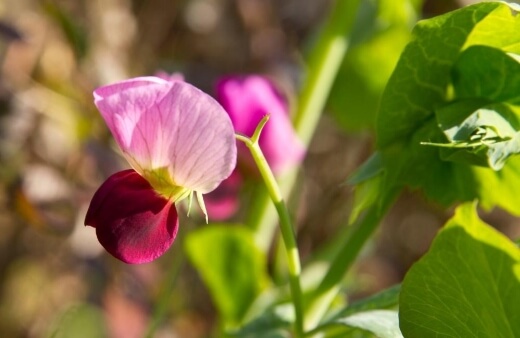
Radish Flowers (Raphanus sativus)
Depending on the variety, flowers may be pink, white or yellow, and will have a distinctive, spicy bite (has a radish flavor). Best used in salads. The Radish shoots with their bright red or white tender stalks are very tasty and are great sautd or in salads.
Radishes are surprisingly hard to grow in Australia, preferred wetter springs that we usually get, but don’t fret, the leaves and flowers are edible if it’s too late to save the root, and are a great spicy addition to salads.
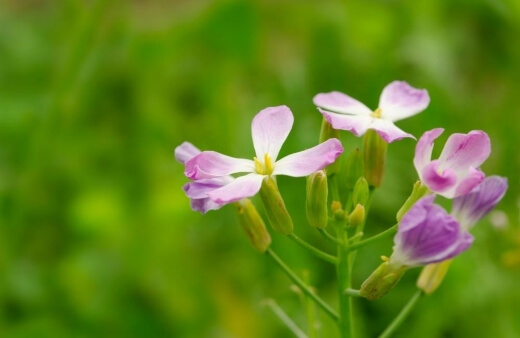
Scarlet Runner Beans (Phaseolus vulgaris)
Have brilliant red blooms that are very tasty and can be served as a garnish for soups, in salads.
Bean pods toughen as they age, so makeuse of young pods as well as flowers.
Runner beans are great, but let’s face it, you’re going to have a glut. Runner beans grow so rapidly in summer that it’s hard to keep up with them, so help reduce the harvest by eating flowers before they’re pollinated.
The sweet, nectar filled petals complement the subtle bean flavour of the flowers perfectly and will make a salad that beats anything you’ve tried before.
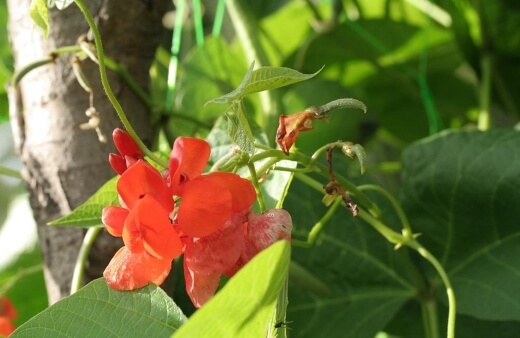
Squash Blossoms(Curcubita pepo)
Squash and pumpkin blossoms are edible and taste mildly of raw squash. Prepare the blossoms by washing and trimming the stems and remove the stamens. Squash blossoms are usually taken off the male plant, which only provides pollen for the female.
In some types of cuisine, such as Italian, squash blossoms are coveted delicacies because their harvest time is brief. The flowers can be fried, stuffed and baked, or added to pasta dishes and soups. Harvest the blossoms and use them in the same day.
Courgette and squash flowers are beautiful when stuffed with rice and minced courgette then baked. The flowers of courgettes hold nectar at their base before they begin to form fruits, but if picked with young fruits attached can be cooked or griddled whole.
By far the best way to use courgette flowers is to stuff them with rice and minced courgette and throw them on the BBQ in summer.
See Zucchini seeds
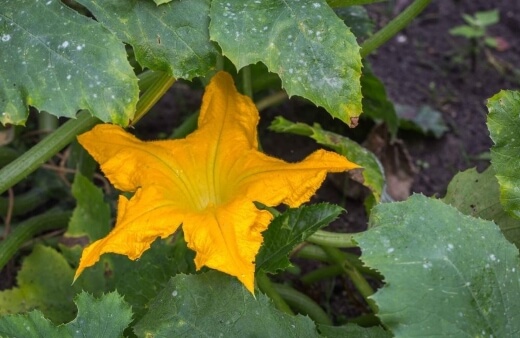
Australia native bush tucker flowers
Bush Cherry (Syzygium australe)
Cherry trees have distinctly varied flavours, but almost all varieties other than shrub cherries have edible flowers. While bush cherry flowers are not particularly flavourful, they do hold their shape so make an excellent garnish for drinks and salads.
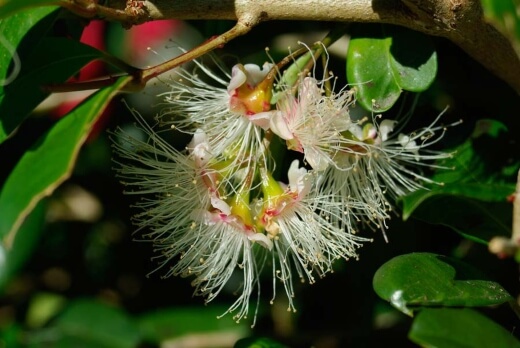
Cape Jasmine (Gardenia jasminoides)
Though not strictly native to Australia, its early introduction has seen Cape Jasmine thrive in our climate, and it makes a wonderful garden flower, with bushy spring growth followed by generously scented summer blooms.
Cape jasmine produces masses of edible flowers whose flavour mirrors their sweet aroma and works well as a sweetener for pickles, vinegars and preserves, or just eaten fresh in salads.
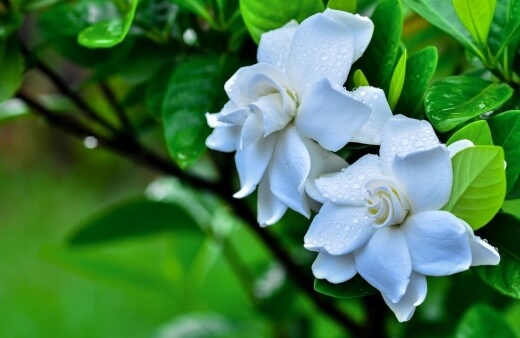
Elderberry (Sambucus australasica)
Elderberry trees, or Sambucus, are dug out of gardens more often than planted, which is a massive shame. Yes, they spread, and they will grow almost anywhere which can make them unattractive garden plants, but the scent of elderflower in the morning through late spring is one of the most joyful moments of any gardening year.
Elderflowers make a beautiful cordial by themselves or can be mixed through cake mixes, added to drinks, or just sprinkled over salads. Always leave half of the flowers on the tree though, so you can benefit from the berries in summer.
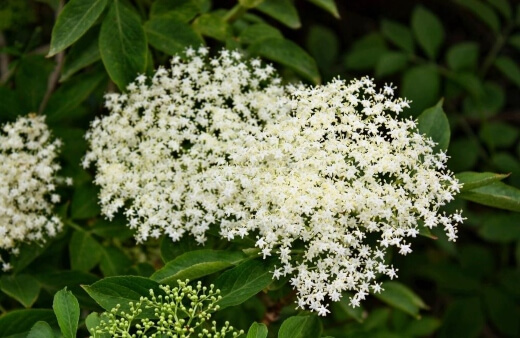
Finger Lime (Citrus australasica)
The Finger Lime has been one of Australia’s biggest exports in recent years within the horticultural trade, with a growing fascination for the sweeter-then-most citrus fruit. Like all citrus trees, finger lime flowers are edible and are much, much, sweeter than the fruits themselves.
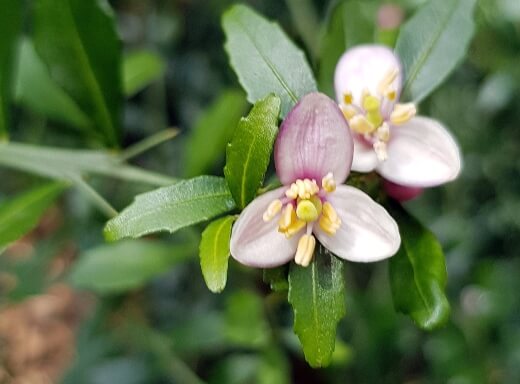
Forget-me-not (Myosotis sylvatica)
Ornamental forget-me-nots and Native Wood forget-me-nots have edible flowers that work well as decorations, though add little in the way of flavour. They can be found growing wild throughout Australia, but also look great as a frothy under-layer to any garden border.

Running Postman (Kennedia prostrata)
If you struggle to grow honeysuckle in your garden, the native Running Postman, or Kennedia, has masses of nectar that build up in a reservoir at the base of each flower.
Their flowers should be harvested early in the day and used to sweeten tea. One great cooking hack is to soak them in milk overnight, then use that milk for cake batters, adding a fragrant sweetness that just elevates baking to another level.
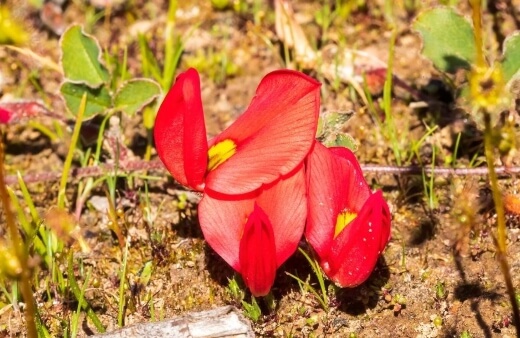
Lemon Myrtle (Backhousia citriodora)
Almost all species of Myrtle come with edible flowers, but lemon myrtle are the only ones truly worth growing for their flowers. The grassy citrus hit from lemon myrtle leaves is carried right through into the flowers, with a subtle sweetness that brings salads to life.
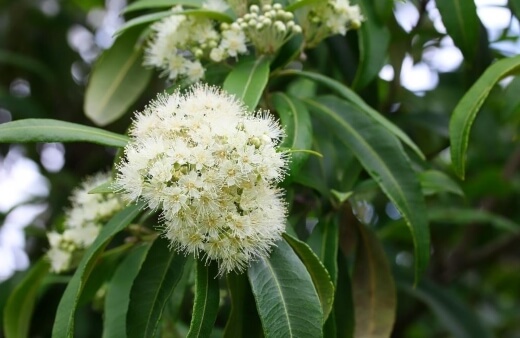
Lemon Scented Tea Tree (Leptospermum liversidgei)
Commonly known as the Lemon Scented Tea Tree, this particular form of tea tree has edible flowers which carry the same intense fragrance as other tea trees but with a zest that helps carry the eye-watering flavour.
Use sparingly in salads by picking petals and sprinkling them individually rather than using whole flowers.
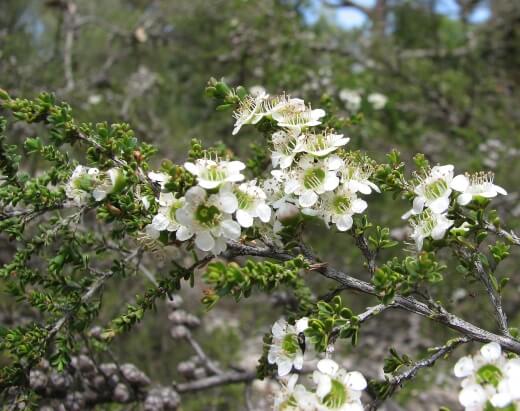
Mint Bush (Prostanthera)
The edible flowers of the mint bush are a great bit of bush tucker for hungry foragers. Prostanthera produce a wash colour in summer and the flowers are safe to eat with a mild minty flavour that works best when cooked.

River Mint (Mentha australis)
All varieties of mint have edible flowers, including the native River Mint. Mint flowers go incredibly well with chocolate but work in savoury foods too. Chopped up finely they can be added to anything for cooking or eaten raw just as well.
One precaution when growing mint as a crop is to keep it contained. Mint spreads easily with sprawling roots and stems that happily root into any soil they can find, so grow mints in pots, or restrict their roots.
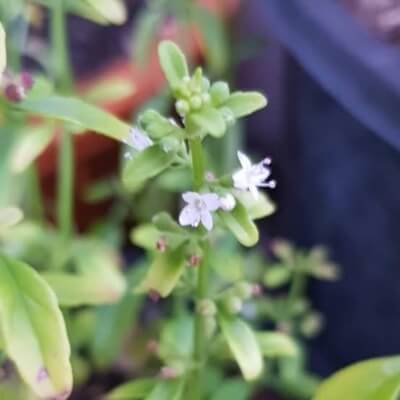
Wahlenbergia
As a native Australian wildflower, Wahlenbergia is one of the easiest edible flowers to grow in Australia, usually reaching just over a foot tall, they produce masses of blue flowers at the tips of long slender stems, and their flowers make an excellent addition to salads.
While Wahlenbergia can tolerate short droughts, they do need to be fairly well watered to produce their distinct tangy flavour.
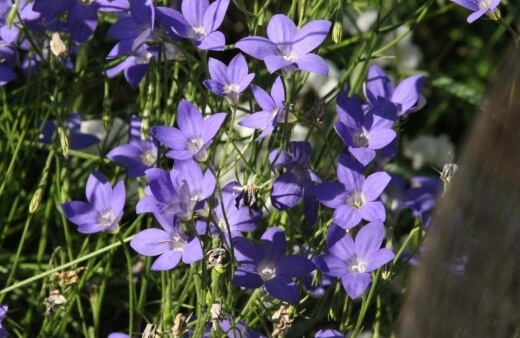
IMPORTANT – Some dos and don’ts!
Following are some simple guidelines to keep in mind before you eat any type of flower:
DO’S:
Eat flowers only when you are positive they are edible. If uncertain, consult a good reference book on edible flowers prior to consumption.
If pesticides are necessary, use only those products labeled for use on edible crops. No flowers is safe to eat unless it was grown organically.
Wash all flowers thoroughly before you eat them.
Introduce flowers into your diet in small quantities one species at a time. Too much of a good thing may cause problems for your digestive system.
Remove pistils and stamens from flowers before eating. Separate the flower petals from the rest of the flower just prior to use to keep wilting to a minimum.
Eat only the flower petals for most flowers except pansies violas, and Johnny-jump-ups (in which they add flavor).
If you have allergies, introduce edible flowers gradually, as they may aggravate some allergies.
DON’TS:
Do not eat flowers from florists, nurseries or garden centers. In many cases these flowers have been treated with pesticides not labeled for food crops.
Do not eat flowers picked from the side of the road. Once again, possible herbicide use eliminates these flowers as a possibility for use.
Just because flowers are served with food served at a restaurant does not mean they are edible. Know your edible flowers – as some chefs do not. It’s easy and very attractive to use flowers for garnish on plates or for decoration, but avoid using non-edible flowers this way. Many people believe that anything on the plate can be eaten. They may not know if the flower is edible or not and may be afraid to ask.
What Flowers are Toxic?
While many flowers in the garden are edible, but not worth eating, there are some that are distinctly toxic and can cause anything from a mildly upset stomach to liver failure.Some of the most common toxic garden plants are listed below, but if you’re ever unsure, don’t eat them!
Common toxic flowers include:
- Daffodil
- Poppy
- Foxglove
- Oleander
- Clematis
- Bluebell
- Rhododendron
- Larkspur
- Hydrangea
- Lily-of-the-Valley
References:
https://www.thepioneerwoman.com/home-lifestyle/gardening/g32723510/edible-flowers/
https://www.healthline.com/nutrition/edible-flowers#TOC_TITLE_HDR_2
https://news.cityofsydney.nsw.gov.au/articles/6-edible-flowers-you-can-grow-in-the-inner-city
https://whatscookingamerica.net/edibleflowers/edibleflowersmain.htm
Continue:
https://aussiegreenthumb.com/edible-flowers-australia/
